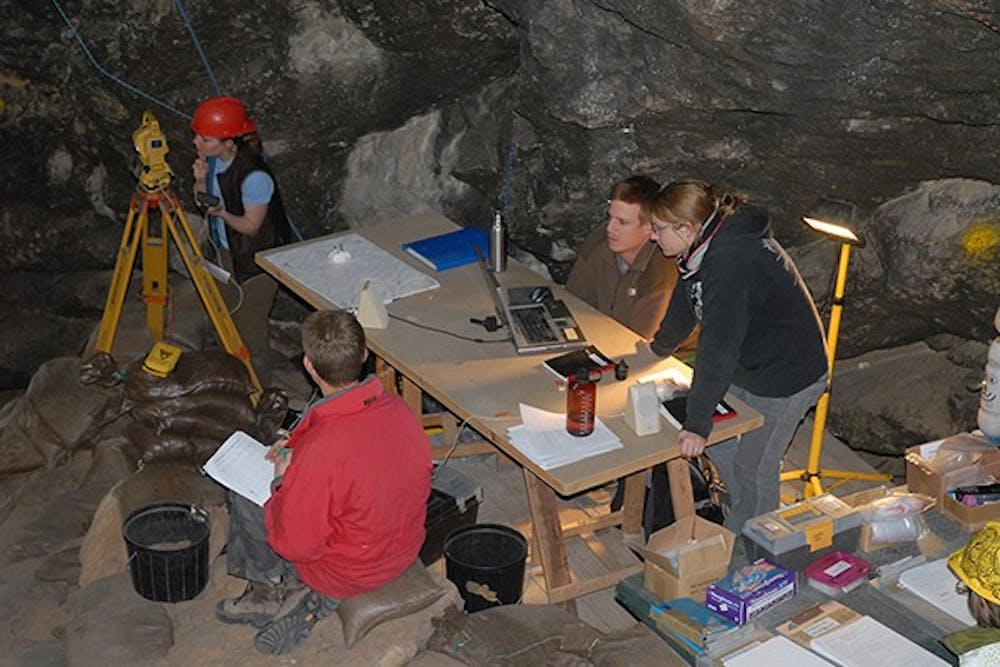 Student members of Professor Marean’s research team work in a Mossel Bay cave. (Photo Courtesy of Julie Russ/Photo by SACP4)
Student members of Professor Marean’s research team work in a Mossel Bay cave. (Photo Courtesy of Julie Russ/Photo by SACP4)A team of nine professors at ASU’s School of Human Evolution and Social Change will be taking a collaborative, multi-project approach to solving the mystery of exactly how humans became human after receiving a $4.9 million dollar grant from the John Templeton Foundation.
The grant was awarded to ASU’s Institute of Human Origins early last month for funding a series of 11 projects in various fields of anthropology over the next three years.
The projects, though entirely separate from one another, will fit together like pieces of a puzzle in order to create a more comprehensive picture of human evolution, physically and socially.
Among the nine ASU researchers who have received funding from the John Templeton Foundation is School of Human Evolution and Social Change Professor Joan Silk.
“The larger project is aimed at bringing together a number of research projects which can speak to the question of how humans got to be the way we are,” Silk said. “Part of the interest in that question is that humans are really different from a lot of other animals, even very different from other closely related primates.”
The funded research projects range from analysis of early stone tools to the study of cooperation among people in modern societies.
Silk said her own research focused on the presence of altruism in modern people.
“Part of the discussion has to do with how humans acquired what seem to be very unusual patterns of cooperation at the group level,” Silk said. “Why are we so nice?”
Under the John Templeton Foundation grant, she plans to expand upon previous research regarding prosocial behavior like sharing in children belonging to different cultures around the world.
Anthropology Professor Gary Schwartz, will be working on a project that will help to determine the “life histories” of early humans with the funding from the grant.
His work will involve studying the teeth of chimpanzees in Liberia in order to create a sort of dental roadmap that can be used on early human fossils.
By studying the evidence that life events like weaning, maturation and motherhood leave behind in the teeth of chimps, Schwartz said he would be able to better see these things in the fossil record.
“Modern humans are really weird primates,” Schwartz said. “But what makes us what we refer to as ‘extreme outliers’?”
He said understanding the rate at which humans grow up is an essential part of answering that question.
 ASU students are able to work in Hadar, Ethiopia, where the fossilized skeleton of “Lucy” was found in 1974 and where some of Bill Kimbel’s research is conducted. (Photo Courtesy of Julie Russ/Photo by Benjamin Reed)
ASU students are able to work in Hadar, Ethiopia, where the fossilized skeleton of “Lucy” was found in 1974 and where some of Bill Kimbel’s research is conducted. (Photo Courtesy of Julie Russ/Photo by Benjamin Reed)Professor Bill Kimbel, who teaches at the School of Human Evolution and Social Change, is the director of the Institute of Human Origins at ASU and highly involved with the John Templeton Foundation grant.
As the IHO director, he spearheaded the two-year application process that preceded the funding by handling paperwork and organizing the team of ASU professors involved, as well as researching his own project on early tool use in east Africa.
Kimbel said the research funded by the grant would address “the evolutionary foundations of human uniqueness — basically, the emergence of characteristics that we consider of high importance to what it means to be human in a scientific context.”
But he said the grant is about more than just discovering the origins of the human race; it is about sharing those origins with students.
In addition to funding for research, the John Templeton Foundation donated $200,000 to the Institute of Human Origins for education outreach to public schools in and around Phoenix.
“Our goal is to enable teachers and students to grasp the evolutionary mindset through … understanding natural selection and the timeline in dynamic, inquiry-based activities,” he said.
He said plans are in the works to upgrade an existing website developed by the Institute of Human Origins called BecomingHuman.org.
However, he said the online resources developed for primary and secondary school educators would be nothing like the online classes students are able to take through ASU.
Instead, the interactive activities and information provided on website will supplement classroom curriculum.
“We want to have a well-informed body of students coming through the public school system,” Kimbel said. "I know this from my own kids’ experience that they learn about the timeline. They learn about the events in evolution, but what they don’t learn about very well is why the knowledge of our past counts as scientific knowledge. I think we can do better.”
Contact the reporter at megann.phillips@gmail.com or follow her on Twitter @megannphillips
Like The State Press on Facebook and follow @statepress on Twitter.




